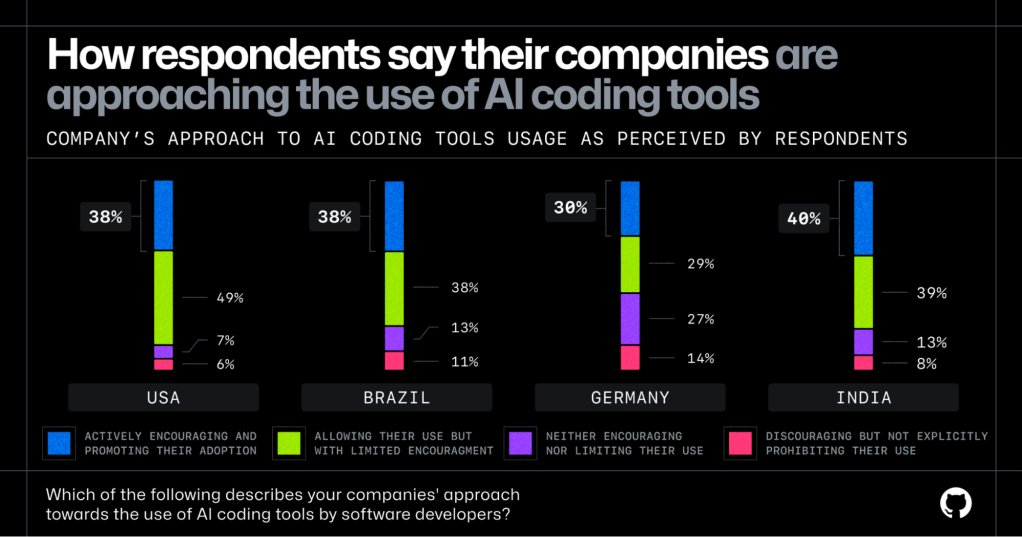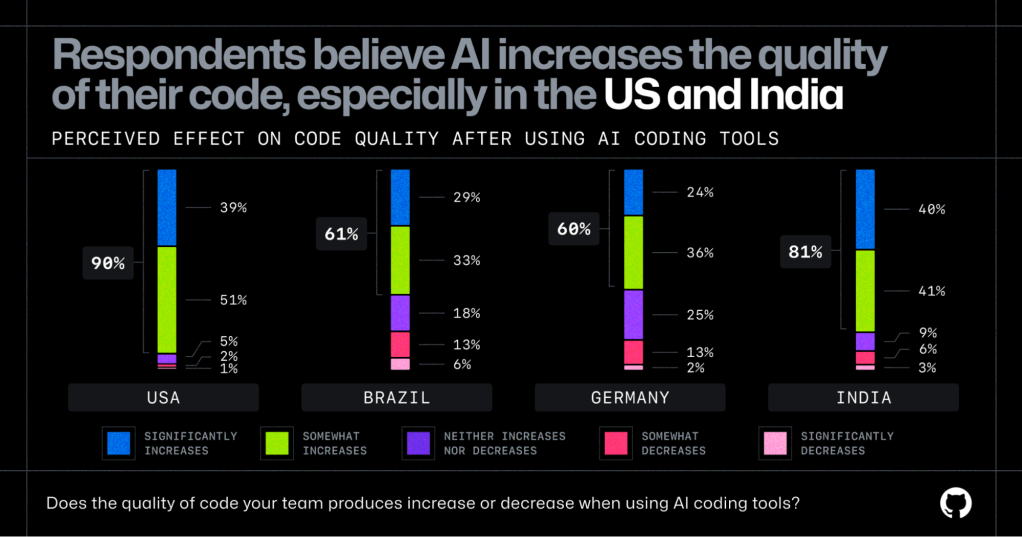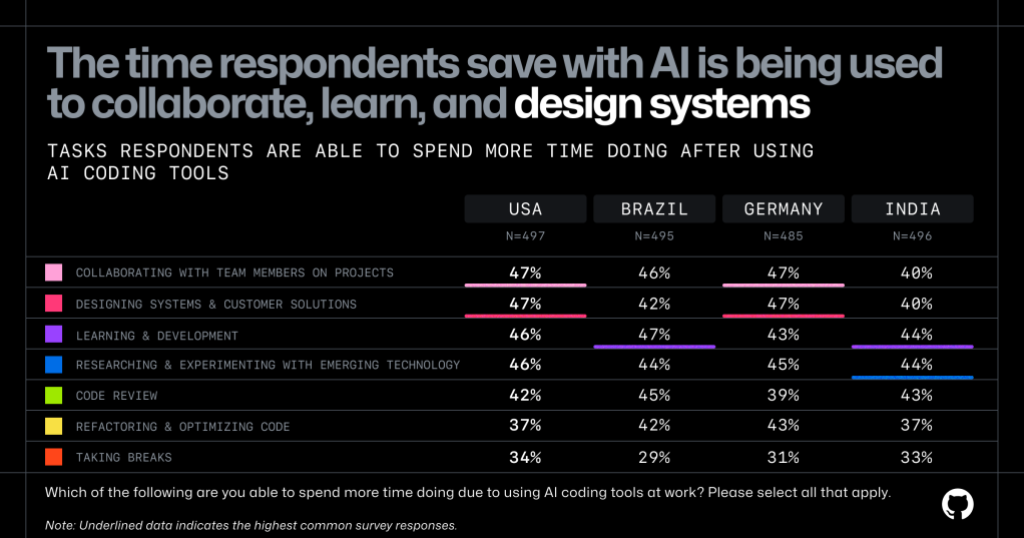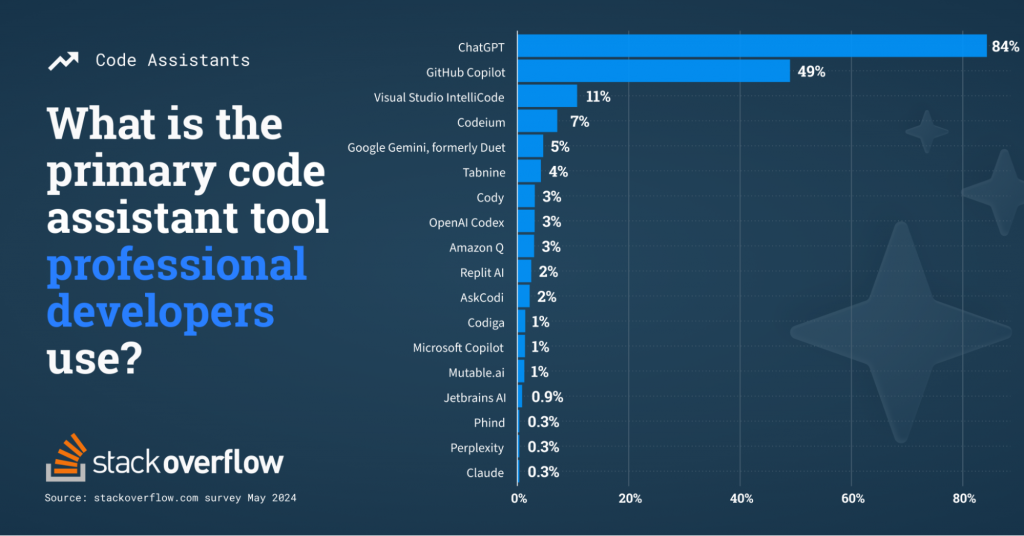Summary
This article explores how generative AI is reshaping software development—how developers use it now, where it still falls short, and what to expect in 2025-2030. It argues that while AI tools are already speeding up prototyping, test generation, and code suggestions, they haven’t quite replaced human oversight, especially in complex systems. The piece also lays out future challenges, including governance, security, and balancing productivity gains with quality control.
Generative AI is already transforming the software development industry. However, it falls short of the most optimistic predictions. The idea that anyone can build a complex software solution by feeding prompts to a coding assistant without involving professional developers remains far from reality. Sadly, politely asking ChatGPT, “Could you build me a billion-dollar SaaS solution… please?” won’t get you anywhere near the desired result. Moreover, the adoption of such coding tools among development companies hasn’t yet brought fundamental changes to how applications are built. So, what does the current landscape of AI in software development look like? In this article, we’ll explore how generative artificial intelligence impacted the industry and offer some predictions for 2025-2030.
Generative AI in Software Development: Highlights and Stats
Almost Everybody Tried AI, but Full Adoption Still Lies Ahead
According to the recent GitHub survey, generative platforms have become nearly universal among the industry specialists. 97% of respondents reported some level of usage.
Despite the widespread use, AI adoption as a fully integrated part of software development remains uneven. Between 30% and 40% of respondents reported that their companies actively encourage and promote the use of coding tools, while 29% to 49% indicated their organizations take a neutral approach, allowing employees to use generative solutions without strong encouragement.
Interestingly, organizations with active promotion of such solutions seem to benefit from simplified development workflows. Nearly half of respondents in these organizations described their toolchains as “simple” to use, compared to only 35% of those in companies with a neutral stance.

Source: The AI wave continues to grow on software development teams
Only 12% of business leaders surveyed by MIT report that the technology has fundamentally transformed the way their solutions are developed. However, a substantial 38% of respondents believe that generative solutions will bring major changes to the software development lifecycle within the next one to three years. Additionally, 31% anticipate that such transformative shifts will occur over a slightly longer timeframe, spanning four to 10 years. This suggests that while generative artificial intelligence in development has yet to fully reshape the industry, the foundation is being laid for a future where its influence will be far more pervasive.
We’re almost there to fully trust AI. Every day brings us a few steps closer to making it a part of our daily workflow. The potential is clear, but there’s still work to be done.
Major Barriers to Widespread AI Adoption in Software Development
Let’s try to figure out what stops companies from wider adoption of generative solutions. One of the most prominent barriers is the perception that these tools struggle to handle higher levels of complexity. Many industry specialists expressed doubts about the ability of coding assistants to deliver consistent results for more intricate development tasks, which limits their integration into critical workflows.
Another barrier is a lack of trust in generative solutions themselves. Teams are hesitant to fully embrace assistants due to concerns over their reliability, accuracy, and potential for introducing errors into the solution’s codebase. This skepticism often prevents organizations from leveraging the full potential of coding assistants.
Read Also Empowering Humanity: Questioning The Dawn of Human-Centered AI
Many people are unaware or unsure if their organization has an AI policy in place. This lack of clarity can create uncertainty and hesitation among teams, further slowing the adoption of generative solutions within development environments.
Accuracy remains a persistent issue with code assistants. According to the StackOverflow survey, 38% of programmers reported that these tools provide inaccurate information at least half of the time. This statistic underscores the need for programmers to critically evaluate AI-generated outputs and maintain oversight throughout the coding process.
More than Coding. What Else Was AI Used For?
Probably, code generation is the first thing that pops out in your head when you hear about using generative platforms in development. However, programmers use many other features such solutions provide throughout the software development lifecycle. As the survey by MIT technology review insights shows, 82% of respondents used generative AI in at least two distinct phases of their development process and 26% of them incorporated it across four or more stages. Common additional use cases include designing and prototyping new features, accelerating the requirement development phase, and streamlining testing processes. Industry specialists also turn to artificial intelligence to enhance bug detection and improve overall code quality.
Read Also How Generative AI Chatbots Enhance Business Operations
Beyond Speed: Better Code, Less Steep Learning Curve for New Technologies, and Test Case Generation
The benefits of using generative tools extend beyond faster coding. According to the already mentioned GitHub survey, people are leveraging artificial intelligence to improve the quality of their work, streamline workflows, and tackle challenges that previously required significant time and effort.
Enhanced Code Quality. One of the standout benefits of generative AI, according to the respondents, is their ability to improve code quality:

Source: The AI wave continues to grow on software development teams
Easy Dive Into New Languages and Codebases. Generative AI is also making it easier for developers to learn new programming languages and navigate unfamiliar codebases their solutions use. Between 60% and 71% of respondents indicated that these platforms made adopting a new language or understanding an existing codebase “easy.” Furthermore, 23% to 29% across different countries described the experience as “very easy.”
Streamlined Test Case Generation. AI tools are proving to be invaluable for generating test cases, with 98% of respondents confirming their organizations have experimented with this capability. Most developers report using such solutions for test generation at least “sometimes.” This trend highlights how traditionally time-consuming tasks are transformed, allowing teams to focus more on solution development and innovation.
How Developers Use All the Free Time They Get with Generative AI
Generative artificial intelligence frees developers from repetitive tasks, which gives them the opportunity to focus on higher-value activities. Mostly, they are leveraging the time saved by coding tools to engage in system design, enhance collaboration, and pursue learning opportunities. For instance, almost half of developers used the extra time generative AI provides to collaborate with team members and refine system architecture:

Source: The AI wave continues to grow on software development teams
ChatGPT, Copilot, and IntelliCode Are Code Assistants Developers Mostly Use
According to StackOverflow’s survey, ChatGPT, GitHub Copilot, and Visual Studio IntelliCode were the most widely used generative solutions. Both professional developers and those learning to code frequently use ChatGPT, with its popularity likely tied to its accessible free version. However, GitHub Copilot sees a higher adoption rate among professional developers (49%) compared to learners (29%), likely due to its time-limited free trial and focus on more advanced features.
Read Also 10+1 Technology Trends to Keep an Eye on
Other solutions, such as Visual Studio IntelliCode, are gaining traction, particularly among those still learning to code. With its free version available to non-enterprise users, IntelliCode has become more popular among learners (16%) than professionals (11%). This illustrates how accessibility and pricing models influence tool adoption across different developer groups.

Satisfaction and Usability. The effectiveness of generative platforms is important, but developers also need to feel comfortable while using the chosen solution. Codeium tops this chart with 84% of respondents ranking it easiest to use. GitHub Copilot and ChatGPT follow, with Copilot scoring 76% for ease of use and 72% for satisfaction, while ChatGPT scores 61% and 65%, respectively.
UI/UX Design: Moving Beyond Pixel-level Details to Focus on the Bigger Picture
Generative solutions have begun to leave the mark on the visual aspects of software development, providing new tools for UI/UX designers and shifting the way design tasks are approached. While AI’s influence has been slower to reach designers compared to coders, 2024 has shown a growing adoption of generative solutions to streamline and enhance creative workflows.
One of the key transformations in design has been the role of artificial intelligence as a creative partner. Solutions like Vercel v0 have empowered designers to generate mood boards, interface mockups, and other visual elements, significantly reducing the time spent on repetitive tasks. Instead of starting with a blank canvas, designers now rely on artificial intelligence as a sounding board, with each prompt yielding multiple visual options. This enables them to focus their efforts on refining usability, aesthetics, and functionality rather than on pixel-level details.
Generative AI has also shortened the path from concept to functional prototype. Rapid prototyping has become more accessible, with tools enabling the quick creation of UI components, from static assets to fully interactive elements. This has given rise to a new breed of professionals known as “design engineers,” who work at the intersection of design and development. These hybrid roles allow for better communication of design trade-offs and foster a more collaborative environment between designers and developers.
However, as Figma’s report shows, AI’s impact on designers has yet to match its influence on developers. While engineers report significant productivity and efficiency gains from AI adoption, being 60% more likely to describe its impact as “transformational,” designers are still adapting to the changing landscape. The success of generative artificial intelligence in design ultimately hinges on how well designers leverage these tools, from selecting the most effective outputs to persuading stakeholders of their choices.
Read Also How AI Search Solves the Problem of Working with Unstructured Data
What’s Next? Predictions for Generative AI in Software Development for 2025-2030
Wider Generative AI Adoption
Frankly, this one’s pretty easy to predict. Almost every programmer has tried generative copilots and in general everyone’s excited about the results. Therefore, in 2025, generative tools are set to play a far more prominent role across the entire software development lifecycle. AI copilots will evolve beyond their current capabilities, gaining the ability to process large-scale codebases, seamlessly integrate complex documentation, and interact with third-party solutions.
This shift, however, will bring both benefits and challenges. On the positive side, AI-driven workflows will enable faster code generation, accelerating development timelines and increasing output. Yet, this speed may amplify familiar concerns, including code reusability, security vulnerabilities, and mounting technical debt.
Additional Measurements and Governance Will Be Required
In 2025, organizations will prioritize refining their development processes to better integrate and measure the impact of generative tools. As artificial intelligence will become more embedded in the software development life cycle, companies will need to focus on improving their workflows to ensure these platforms deliver measurable results.
The adoption of Software Engineering Intelligence (SEI) platforms will play an important role in this transformation. These solutions provide critical insights that enable businesses to effectively govern artificial intelligence adoption, align development efforts with broader business objectives, and monitor performance across production environments.
This emphasis on measurement and governance will ensure that the integration process doesn’t just accelerate development but also enhances quality of delivered solutions, overall efficiency, and alignment with business goals.
New Bottlenecks in Software Delivery Will Surface
As AI-assisted development accelerates individual developer productivity and increases the volume of code produced, companies will face new bottlenecks across the broader software delivery lifecycle. Faster coding speeds won’t automatically translate to faster time-to-market unless the rest of the development pipeline keeps pace.
Companies that have yet to invest in key enablers, such as test automation, built-in security practices, release orchestration, or code scanning, may struggle to capitalize on the productivity gains offered by generative tools.
Security and Risk Prediction Will Take Center Stage
As artificial intelligence reshapes the software development lifecycle, the focus on security and risk prediction will surpass productivity gains as a top priority. Generative AI’s growing influence on planning, coding, testing, and deployment introduces new challenges, especially as AI-driven reverse engineering and attack tools become increasingly sophisticated.
Threat actors are expected to exploit these advancements, using them to analyze application behavior, extract sensitive data, and misuse APIs, escalating the scale and complexity of cyberattacks. With the rapid pace of AI-driven development, enterprise organizations are likely to continue ramping up investments in advanced security and risk management solutions to safeguard their systems against evolving threats.
However, over-reliance on artificial intelligence without proper governance will remain a critical issue. Lack of oversight can lead to security lapses, ethical challenges, and unintended consequences, underscoring the importance of establishing clear frameworks for further governance.
In response to this escalating threat landscape, security teams are expected to adopt artificial intelligence themselves in 2025. Early adopters will leverage machine learning-assisted threat analytics to identify patterns in attack behavior, enabling them to mitigate risks more effectively and keep pace in the cybersecurity arms race. This integration of artificial intelligence into security workflows will be essential for combating increasingly advanced cyber threats.
The Temptation to Replace Development Teams with AI Will Be Too High
That’s an interesting one and it comes from the list of Forrester predictions. In 2025-2030, some organizations may attempt to replace significant portions of their development teams with artificial intelligence (potentially as much as 50%) only to find that this approach falls short. Forrester predicts such experiments are likely to fail, highlighting a fundamental misunderstanding of a developer’s role.
Which brings us to the next one.
Generative AI Can’t Replace Developers (Yet?)
While generative coding assistants can significantly enhance productivity, coding is just one part of a developer’s workload. Forrester’s survey reveals that developers spend only about 24% of their time writing code. The rest is devoted to essential tasks such as creating software designs, writing and running tests, debugging issues, and collaborating with stakeholders. These activities require critical thinking, creativity, and communication, skills that AI tools, as they currently stand, cannot replicate or replace.
In 2025-2030, the conversation will shift from replacing developers to augmenting them. Here, generative artificial intelligence will act as a tool that enhances human capabilities rather than a substitute for human expertise.
Read Also How to Build a Custom Scheduling App Faster with Lovable AI and DHTMLX Scheduler
Conclusions
No doubt, generative tools that can help with every part of a solution you need to build, from mockups, to coding, and testing, are groundbreaking. Enterprises, however, remain wary of introducing AI everywhere at once without proper supervision. And not without reason. Generative artificial intelligence is mature enough to improve the performance of those specialists who know well what they’re doing. Yet it can still produce errors that can cost the reputation of the company that failed to track them down.
If you’re looking for innovative software solutions, whether you need AI-powered capabilities or not, our team is here to help. Contact us today to discuss your project and discover how we can bring your vision to life.